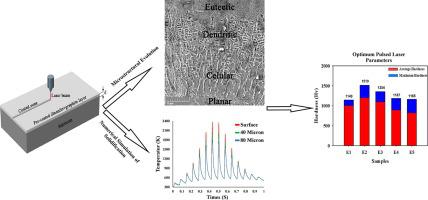Optics & Laser Technology ( IF 4.6 ) Pub Date : 2020-11-02 , DOI: 10.1016/j.optlastec.2020.106693 Arman Khalili , Milad Mojtahedi , Alireza Qaderi , Massoud Goodarzi , Mohammad Javad Torkamany

|
In the present study, the pulsed laser utilized to synthesize the in-situ Fe-TiC hard layer on carbon steel. In this respect, ilmenite, as an inexpensive raw material, was used for the first time in laser cladding. The effect of pulse parameters on the microstructure and hardness of the clad layer was investigated. The solidification of the weld pool was started in planar form and then transformed to columnar, dendritic, and finally lamellar eutectic. Thus, an appropriate structure with a high density of hard particles was obtained near the surface. The effects of laser scan speed and pulse duration on the evolution of the solidification structure were investigated. It was found out that the volume fraction of regions with different solidification modes can be adjusted. The properties of the hard layer can be manipulated in this regard. Increasing the laser scan rate from 1 to 5 mm/s reduced the thickness of the clad layer from 135 to 70 µm, while increased the fraction of the planar growth region from 7% to 46% of the clad thickness. Numerical simulation by finite element method was also implemented for better realizing the influence of parameters. To achieve this aim, the variations of temperature and temperature gradient were analyzed. The results revealed that the effect of the laser scan speed is more significant than the pulse duration. Eventually, 2 mm/s and 8 ms were defined as the optimized process parameters. The average hardness of the produced clad is improved eight times higher than the substrate.
中文翻译:

脉冲激光参数对原位Fe-TiC硬层显微组织的影响:仿真与实验
在本研究中,脉冲激光用于在碳钢上合成原位Fe-TiC硬层。在这方面,钛铁矿作为廉价的原材料首次用于激光熔覆。研究了脉冲参数对复合层组织和硬度的影响。焊缝的凝固以平面形式开始,然后转变为柱状,树枝状,最后是层状共晶。因此,在表面附近获得了具有高密度的硬颗粒的适当结构。研究了激光扫描速度和脉冲持续时间对凝固组织演变的影响。发现可以调节具有不同凝固模式的区域的体积分数。在这方面可以控制硬层的特性。将激光扫描速率从1 mm / s增加到5 mm / s,可将包层的厚度从135微米减少到70 µm,而将平面生长区域的比例从包层厚度的7%增加到46%。为了更好地实现参数的影响,还进行了有限元数值模拟。为了达到这个目的,分析了温度和温度梯度的变化。结果表明,激光扫描速度的影响比脉冲持续时间更显着。最终,将2 mm / s和8 ms定义为优化的过程参数。所生产的覆层的平均硬度比基材提高了八倍。而平面生长区域的比例从包层厚度的7%增加到46%。为了更好地实现参数的影响,还进行了有限元数值模拟。为了达到这个目的,分析了温度和温度梯度的变化。结果表明,激光扫描速度的影响比脉冲持续时间更显着。最终,将2 mm / s和8 ms定义为优化的过程参数。所生产的覆层的平均硬度比基材提高了八倍。而平面生长区域的比例从包层厚度的7%增加到46%。为了更好地实现参数的影响,还进行了有限元数值模拟。为了达到这个目的,分析了温度和温度梯度的变化。结果表明,激光扫描速度的影响比脉冲持续时间更显着。最终,将2 mm / s和8 ms定义为优化的过程参数。所生产的覆层的平均硬度比基材提高了八倍。结果表明,激光扫描速度的影响比脉冲持续时间更显着。最终,将2 mm / s和8 ms定义为优化的过程参数。所生产的覆层的平均硬度比基材提高了八倍。结果表明,激光扫描速度的影响比脉冲持续时间更显着。最终,将2 mm / s和8 ms定义为优化的过程参数。所生产的覆层的平均硬度比基材提高了八倍。











































 京公网安备 11010802027423号
京公网安备 11010802027423号